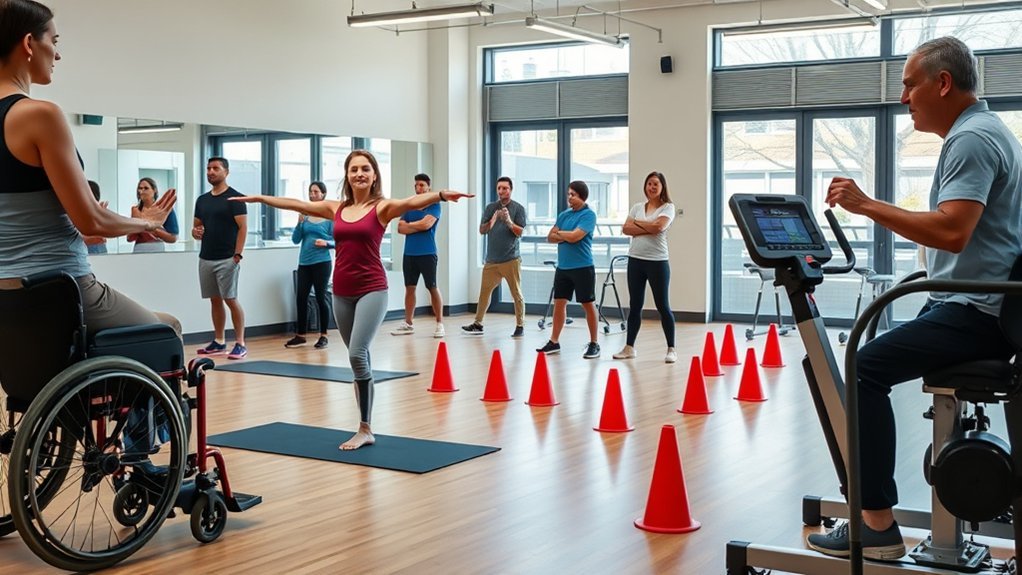While some thrive in high-intensity workouts, others may struggle to keep up with traditional routines. Understanding how to make activity modifications is vital for ensuring everyone can engage meaningfully in physical fitness. You might have questions about specific adjustments or how to communicate these changes effectively in a group setting. Exploring these aspects can empower you to create a more inclusive environment for all participants. What are the best strategies to implement these modifications?
What Are Activity Modifications and Why Are They Important?
Activity modifications refer to adjustments made to tasks or exercises to accommodate individual needs, ensuring that everyone can participate meaningfully.
These modifications are essential because they create an inclusive environment where you can engage fully, regardless of your physical abilities or limitations. By tailoring activities, you not only enhance your experience but also improve your overall well-being.
Understanding the importance of these modifications allows you to advocate for yourself and others, fostering a supportive atmosphere.
Whether you’re recovering from an injury or managing a chronic condition, recognizing that you can adjust activities empowers you.
Ultimately, activity modifications help you maintain motivation and achieve personal goals while promoting a sense of belonging within any group setting.
How Can I Modify Common Exercises for My Needs?
When it comes to exercising, modifications can make a significant difference in your ability to participate comfortably and effectively.
Here are some ways to adapt common exercises to suit your needs:
- Push-Ups: Try wall push-ups or perform them on your knees to reduce strain on your shoulders and wrists.
- Squats: Use a chair for support, or perform partial squats to limit the range of motion.
- Lunges: Step back instead of forward or use a support, like a wall or sturdy furniture, for balance.
- Planks: Start on your knees or elevate your hands on a bench to lessen the intensity.
These modifications can help guarantee you’re engaging in exercises that feel safe and effective for you.
Tips for Communicating Modifications in Group Classes
Effective communication is key when discussing modifications in group classes. Start by clearly explaining the reasons behind the modifications, making certain participants understand their importance.
Use simple language and avoid jargon to keep everyone on the same page. Encourage an open dialogue; ask questions to gauge comfort levels and address concerns.
Demonstrate the modifications yourself, allowing participants to see how they can be applied effectively. Remind everyone that modifications aren’t a sign of weakness but a way to enhance their experience.
Foster a supportive environment where participants feel comfortable sharing their needs. Finally, check in regularly to make sure everyone feels included and understood, reinforcing that your goal is to support their journey toward fitness and well-being.
How to Assess When a Modification Is Necessary
How can you determine if a modification is necessary during a class? It’s essential to assess the situation actively. Here are four considerations to guide you:
- Participant Feedback: Listen to students’ concerns about their comfort or ability levels.
- Observation: Watch for signs of struggle or discomfort, like difficulty completing an activity correctly.
- Safety Risks: Identify any movements that may lead to injury based on individual capabilities.
- Progress Monitoring: Evaluate if participants are meeting their goals; if not, a modification might be needed.
Resources for Learning More About Activity Modifications
As you explore the topic of activity modifications, you’ll find a wealth of resources designed to enhance your understanding and application of these techniques.
Start with reputable websites like the Centers for Disease Control and Prevention (CDC) and the American Occupational Therapy Association (AOTA), which offer guidelines and evidence-based practices.
Explore trusted resources like the CDC and AOTA for guidelines and evidence-based practices on activity modifications.
You can also read books focused on adaptive strategies, such as “The Adaptive Sports and Recreation Resource Guide.”
Online courses and webinars can provide interactive learning experiences, while local support groups can connect you with peers facing similar challenges.
Don’t hesitate to consult professionals like occupational therapists for personalized advice.
Frequently Asked Questions
Can I Modify Activities for Specific Medical Conditions?
Yes, you can modify activities for specific medical conditions. It’s important to take into account your health needs and consult with a healthcare professional to guarantee the modifications are safe and effective for your situation.
How Do I Know if a Modification Is Effective?
You’ll know a modification’s effective when you feel stronger, like a plant thriving in better soil. Track your progress, listen to your body, and adjust as needed; improvement is a strong sign you’re on the right path.
Are Modifications Suitable for All Fitness Levels?
Yes, modifications are suitable for all fitness levels. They help you adapt exercises to your abilities, ensuring you engage safely and effectively. Everyone can benefit from tailored adjustments to enhance their fitness journey.
What Are Some Common Misconceptions About Activity Modifications?
You might think activity modifications are just for beginners or injured folks, but that’s not true. Everyone can benefit from adjustments to enhance their performance, prevent injuries, and make workouts more enjoyable at any fitness level.
How Can I Encourage Others to Embrace Modifications?
You can encourage others by sharing personal experiences, highlighting benefits, and fostering a supportive environment. Show empathy, listen to concerns, and reinforce that modifications enhance participation, making activities enjoyable and accessible for everyone involved.
Conclusion
Incorporating activity modifications can transform your experience, ensuring you feel included and empowered. Imagine stepping into a class where your needs are met with understanding and creativity. The journey to finding the right adjustments might feel intimidating, but the rewards—enhanced participation and confidence—are worth it. As you explore these resources and communicate your needs, remember: every small change can lead to a significant impact. Will you take the next step towards a more fulfilling activity experience?
